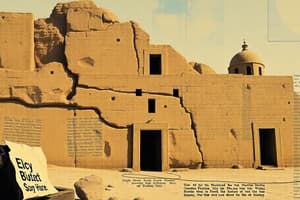Podcast
Questions and Answers
What is the period known as the New Stone Age called?
What is the period known as the New Stone Age called?
- Paleolithic
- Neolithic (correct)
- Protohistoric
- Mesolithic
What was a significant change in lifestyle during the Neolithic period compared to the earlier periods?
What was a significant change in lifestyle during the Neolithic period compared to the earlier periods?
- People became completely nomadic.
- People began to use bronze tools.
- People relied solely on hunting and gathering.
- People started to settle in one place and began farming. (correct)
What does the term 'dynasty' refer to in the context of Ancient Egypt?
What does the term 'dynasty' refer to in the context of Ancient Egypt?
- A period when people from one family ruled. (correct)
- A phase of significant cultural decline.
- A period when the government was ruled by military leaders.
- A time when foreign rulers controlled Egypt.
Which major cities were known as the main cities of ancient Egypt?
Which major cities were known as the main cities of ancient Egypt?
Why is the Nile River referred to as 'the gift of the Nile'?
Why is the Nile River referred to as 'the gift of the Nile'?
What was the Inundation in Ancient Egypt?
What was the Inundation in Ancient Egypt?
During which period were people known to use dogs for hunting?
During which period were people known to use dogs for hunting?
Which of the following statements about Jabal Faya is correct?
Which of the following statements about Jabal Faya is correct?
Flashcards are hidden until you start studying
Study Notes
Stone Age in the Arabian Peninsula
- Stone tools from 125,000 years ago were discovered in Jabal Faya, Sharjah, indicating the presence of Stone Age people in the Arabian Peninsula.
- Early humans were nomadic, moving from place to place in search of food.
- They developed stone tools for hunting animals and gathering plants.
Stone Age Eras
- Paleolithic Period (Old Stone Age): lasted until 10,000 BCE, with humans still nomadic.
- Mesolithic Period (Middle Stone Age): lasted from 10,000 BCE to 8,000 BCE, with humans still nomadic but using dogs for hunting.
- Neolithic Period (New Stone Age): Lasted from 8,000 BCE to 4,000 BCE, with humans settling in one place and developing agriculture and animal husbandry.
Ancient Egyptian Civilization
- The Narmer Palette (discovered in Egypt 100 years ago) is a 5,000-year-old stone carving depicting King Narmer, the first ruler of a unified Egypt.
- Narmer's reign marked the beginning of the 1st Dynasty of Egypt, which lasted for over 3,000 years, divided into over 30 dynasties.
- The last dynasty ended in 30 BCE when Egypt was conquered by the Roman Empire.
The Nile River's Significance
- The Nile River was central to ancient Egyptian civilization, with the famous historian Herodotus stating, "Egypt is the gift of the Nile."
- Cities like Memphis and Thebes were located on the Nile, providing Egyptians with food (fish), transportation, and resources.
- The Nile's annual flooding (known as the Inundation) brought fertile soil to the land, vital for agriculture.
Studying That Suits You
Use AI to generate personalized quizzes and flashcards to suit your learning preferences.




